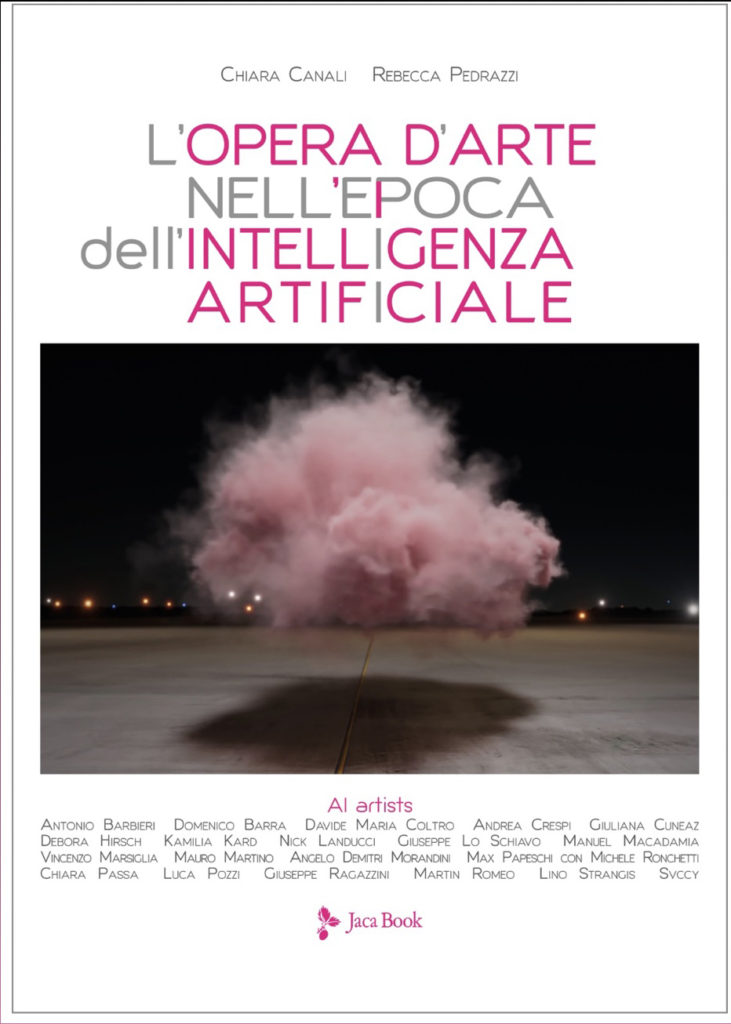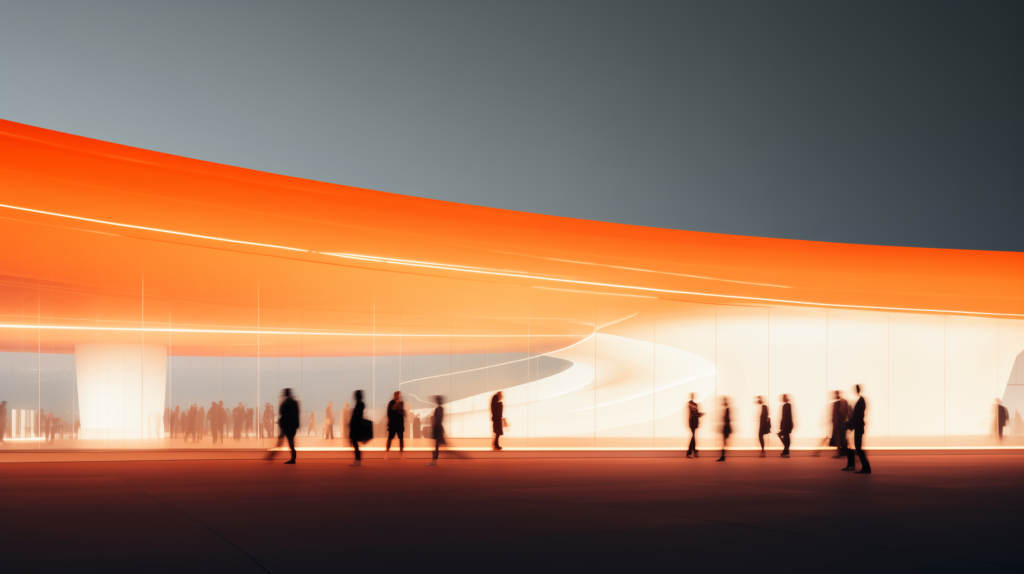
Here is my article in the catalog of the art exhibition held in Parma between April and May 2024 entitled: “Art in the Age of Artificial Intelligence”
Exhibit and Catalogue by Rebecca Pedrazzi, Chiara Canali, Davide Sarchioni.
The age of “Extended ART”: Towards the integration between reality and the metaverse.
“Human beings are no longer at the center of the epochal changes we are witnessing but have become part of a continuous flow of relationships, a complex network of interactions between humans, artificial intelligences, and machines. This network extends from the real to the virtual, giving rise to new visions of reality and, consequently, to new relational models, even in the creative field.”

INTRO by Stefano Lazzari aka Stex Auer
Let’s start with a paradox, and we will find several along our journey into art generated by cultures in virtual worlds. What is the subtle membrane that separates any digital representation of a form, whether abstract or resembling the real, inserted into the digital representation of a virtual world where everything, from blades of grass to clouds, from cities to our own bodies in which we represent ourselves, is the work of creativity?
The digital nature of these worlds, and here opens an endless debate on the meaning of the nature that the digital has profoundly reshaped, should not be treated as it usually happens as a reflection of reality, a sort of more or less successful pantomime, a tracing that models reality to reproduce it, but rather as an otherness, a plausible nature, but not therefore subservient to reality, but rather preceding it, foreshadowing it, overturning the stereotype of a virtual world in which reality is reflected, creating a double of the truth.
Instead, the opposite is becoming increasingly true: it is the imaginary that anticipates and produces reality, or at least part of it, in a continuous passage of meaning between the domain of atoms and that of bytes, an ambivalent, skeuomorphic dimension, where fragments of reality and imagination coexist and blend seamlessly. And in this union, the paradox dissolves, because reality and imagination do not stack up, overlap, or reject each other, but rather they harmonize and integrate into a new and original universe of sense and meanings perfectly understandable. From this typical process of digital modernity derives a culture of the immaterial that is no different from what historically has happened in all human societies, even the most remote and ancient, from its artifacts, as they have been shaped and decorated, and from which we deduce an identity symbolic world and consequently how that human culture interprets and concretely lives the world around it.
Understanding the immaterial art of the Metaverses means understanding which cultures and societies create it. In the digital Metaverse, art is a fundamental part of its existence. The Creator in this User Generated Content universe is socially indeed part of an upper class; the artist is the cornerstone of the success or failure of the technological platformin which the human culture that populates it has taken up residence.
ARTICLE:
Human beings are no longer at the center of the epochal changes we are witnessing but have become part of a continuous flow of relationships, a complex network of interactions between humans, artificial intelligences, and machines. This network extends from the real to the virtual, giving rise to new visions of reality and, consequently, to new relational models, even in the creative field.
This allows us to think of forms of “collaborative intelligence” capable of producing unprecedented paradigms through which to reinterpret creativity and art. This concept of expanded collaboration leads us to reflect on the extensibility of our reality, our identity, and consequently, our creative potential.
A line of thought that, in my opinion, would be interesting to explore is that of symbiotic experimentation between different types of intelligence, namely the creation of creative hubs formed by humans and generative artificial intelligence systems in extended reality (XR) environments.
True laboratories of ideas, which do not seek immediate understanding or universal approval but rather aim to propose new paradigms and slowly disseminate their visions, influencing the social fabric at a molecular level.
“New nuclei, new creative and thought elites are emerging. There is a space, which is a laboratory space that no longer wants, as the avant-gardists wanted to do at the beginning of the twentieth century, to drag the masses, their approach is absolutely soft but they distill very useful poisons that will slowly contaminate the rest of the world. This is the most important mutation that has been happening for twenty years.” [Philippe Daverio]
On our part, we think of art not only as an expressive form but as an “extendable ecosystem” in which multiple interconnected elements and parallel disciplines coexist, all part of a fabric that extends between the real and the virtual. In doing so, the physical/digital interaction forms the basis of creative chemistry, which is why we have conceived the concept of “Extended Art.”

The concept of “extensibility” is also at the core of my projects as a metaverse architect, for which my creations are effectively open and expandable. I am not interested in the reproduction or reproducibility of real architecture but in the creation of typically metaverse environments for which there are no fundamental elements such as roofs or windows or walls, but structures that give the aesthetic sense of architecture.
The idea of developing creations and experiences based on generative AI models and representing them within extended reality platforms has become a point of interest through which to propose new immersive experiences.
From the beginning of my work, I have always understood metaverse spaces as “incubators of experiences” where the environment, architecture, immersive depth, and social experience become the fulcrum of the entire creative dynamic.
Entering the realm of XR and particularly virtual reality, we can discover infinite creative spaces within metaverses. These, although substantially different from each other, share some essential rules, including the importance of the “creators” and the participatory and social needs of those who inhabit them.
The approach we have embraced for more than a decade aligns closely with that proposed by Professor Luciano Floridi, namely that “humans, in imagining the future, should not seek to adapt technology to their own imagination but to do the opposite.”
Therefore, “We should not conceive the metaverse as a mere virtual replica of reality, but as a fluid extension of it, endowed with autonomous characteristics.”

The question arises spontaneously: “How can we bring about a creative process that takes into account those ‘autonomous characteristics’ and develop new artistic environments that are a bridge between real and virtual models?”
One answer could be “merging the two realities into a single hybrid form” or designing and developing experiences in Mixed Reality. This would involve producing virtual spaces within real environments with the physical presence of both humans and avatars.
An approach that leaves ample room for imagination and clearly highlights that expressive forms such as set design, architecture, design, performance, and theater can play a fundamental role in the writing and realization of these hybrid spaces within art galleries and museums.
The choice of devices and forms of representation plays a crucial role. Referring to past experiences, we can say that many experiments have been conducted in connecting real and virtual spaces within cultural events. The so-called “crossover” events (or “phygital”) that involve metaverse environments (with the presence of avatars) broadcast “live” on large screens.
Other experiments, more immersive and artistically credible, involve the use of VR headsets. In these collective artistic experiences, the same virtual space is shared by multiple subjects physically present in the same location.
A similar type of experimentation, but one that could involve larger audiences, concerns the use of “immersive rooms.” This technique involves the live projection of metaverse spaces in 360° on the walls of a suitable room, allowing viewers to experience immersive experiences directly and without the use of headsets.
From a creative and performative perspective, I believe that the most suitable environments for realizing a credible type of hybridization are those related to Mixed Reality (MR), where it is possible, through the use of XR headsets, to experience environments where virtual spaces and objects are seamlessly integrated into real environments. This naturally immerses the viewer’s experience in the hybrid space. Furthermore, through the use of integrated tools, it might be possible to realize fluid experiences using algorithmic systems and with the assistance of generative artificial intelligence tools.
“Generative Art in XR represents the pinnacle of creative evolution in the digital age, where creativity transcends the boundaries of the tangible and immerses itself in the domain of extended reality, an encounter between the physical and virtual worlds. In this realm, art is not just representation or expression but immersive experience. The artist does not simply define shapes and colors but conceives a system that can manifest itself as an algorithm, a procedure, or a set of rules and gives rise to interactive works in virtual, augmented, or mixed reality (XR).”
Dario Buratti

Comments are closed.